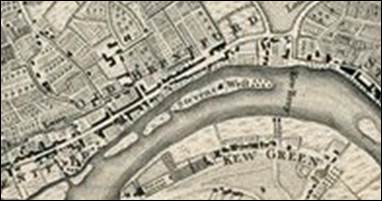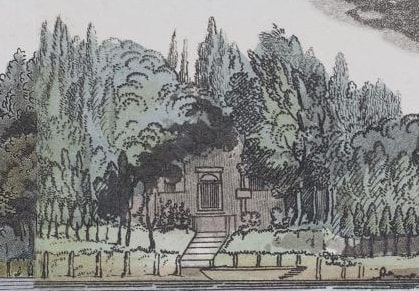Basics
Home and SearchSite Guide
Brentford Basics
Privacy Policy
Contact
People
FamiliesPhotos of people
Name indexes incl WW1
Memories
Lists, Documents, News
Occupations
Properties
Properties: High StreetProperties: non-High Street
Photos
Maps
1909/10 Valuation Index
Pub Hub
Can You Help?
Seeking...Mystery photos
Roads Off
A-Z listJanet's Research
HistoryBeach's Jam
Nowell Parr
Turner the Artist
Queen Victoria 1840
Brentford Market
80 High Street
Clitherow of Boston House
Four Croxford Brothers
Sources & More
They SaidBooks etc.
Web Links
Next
Site Technology
Author
Home and Search
Not Brentford
THE SWAN, BRENTFORD
Jim Storrar has researched the history of the Swan. This was at a rather different location to most Brentford pubs, accessible only by boat...The Three Swans / The Swan Tavern, Brentford Ait
Brentford Ait is a long 4.6 acre (1.9 ha) uninhabited island in the River Thames, now with no buildings. In the past the ait has also been called Makenshaw, Mattenshaw and Twigg Ait. It is administered by the London Borough of Richmond upon Thames and the Port of London Authority. Brentford Ait has a gap in the middle known as Hog Hole which is apparent at lower tides, dividing the ait into "upper" and "lower" sections. The ait was planted with trees in the 1920s to screen Brentford's gasworks from the view of Kew Gardens.The London Borough of Hounslow administers the neighbouring Lot's Island separated by thick, shifting mud at low tide.
The Three Swans dated back to at least 1729 when it was held by Stephen West of Kew and by 1780 it was still in the ownership of the West family. The West family had originally made a considerable fortune from fishing rights.
Stephen West was first granted a publican’s licence in 1724 and in 1729 he was specifically granted a licence for The Swan Tavern. According to some sources he built the original tavern and in 1729 he held the rights to land passengers on the Kew side of the Thames. (1, 2)
Situated on Brentford Ait, this was a well-known house and a rendezvous for river outings. It was noted to be a good eel house.
 |
|
John Rocque’s map (published in 1746) clearly shows the position of The Swan on Brentford Ait. This is the same position as shown in the Manorial Survey of 1771 (see below) |
Samuel Richardson in Clarissa, his novel of 1748, wrote that Clarissa:
"… after rowing about put in at the Swan at Brentford-ait where she dined; and would have written, but had no conveniency either of tolerable pens, or ink, or private room .. " (3)
In the novel Clarissa is a young and virtuous woman who ends up falling victim to Robert Lovelace after he convinces her to run away with him and he ends up raping her.

The 1771 Manorial Survey showing a plan of The Swan Tavern, its fish ponds and orchards.(4)
William Hickey, a lawyer, noted in his diary in 1780 that he had "dined upon the island off the town of Brentford where there is a house famous for dressing pitchcooked eels and also for stewing the same fish". Pitchcooked or pitchcocked eels were rubbed with salt, pepper and salt and then skewered before being broiled with beef suet on a gridiron and possibly served with butter and parsley. (5, 6)
It is said that this was where the Prince of Wales (later George IV) held secret rendezvous with his mistress, the actress Mary "Perdita" Robinson. Mary and the Prince of Wales met in 1779 after she had played the role of Perdita in The Winter’s Tale at The Theatre Royal in Drury Lane. The next day she received a note from him signed "Florizel". Letter after letter followed and eventually, though at first she was very cautious about it, she became his mistress. Because of the way she had met the Prince, she was known thereafter as Perdita by the cartoonists and therefore by the public as well. After months of keeping the Prince at arms’ length Mary finally surrendered her body to him at The Three Swans. They had further assignations in a small brick house not far from Kew.
The Prince never let on to his father, King George III, and during the affair, which lasted four years, he gave her a promissory note that he would give her £20,000 when he came of age. When inevitably there came a point when the Prince cast his eye elsewhere, poor Mary's time with him was up. The Prince never paid up as he had promised – he had no money of his own – so, in 1780, Mary threatened to publish their letters unless George III paid £5,000 to recover them. After much wrangling she was given the substantial amount of a £500 annuity. (7)
Mary Robinson recalled in a letter of 1783 in her memoirs that she would wait for a signal from Kew Palace to meet with him:
"At length an evening was fixed for this long-dreaded interview (with the Prince). Lord Malden and myself dined at the inn on the island between Kew and Brentford. We waited the signal for crossing the river in a boat which had been engaged for the purpose. … I admired the Prince; I felt grateful for his affection. He was the most engaging of created beings. I had corresponded with him during many months, and his eloquent letters, the exquisite sensibility which breathed through every line, his ardent professions of adoration, had combined to shake my feeble resolution. The handkerchief was waved on the opposite shore … and in a few minutes we landed before the gates of old Kew Palace." (8)
Many years after the event she told a friend that she and the Prince of Wales had dined on Brentford Ait in 1780. William Makepeace Thackeray portrayed George IV in his satirical ballad The King of Brentford’s Testament9, 10)
The Three Swans went through a number of licensees and it developed a reputation for rowdiness and immorality. It became a continual cause of annoyance to the residents around Kew Green, who were in earshot.
In 1793 The Three Swans passed from Henry West, Stephen’s brother, to Thomas Samuel Maycock and from him to Elizabeth Leigh and her descendants.
Robert Hunter, living in one of the fine houses on Kew Green, regarded the island and The Three Swans with disdain: "Brentford Ait is a great nuisance to this parish and the neighbourhood on both sides of the river, …. the house of entertainment has long been a harbour of the men and women of the worst description, where riotous and indecent scenes are often exhibited during the summer months and on Sundays."
In 1812 Hunter bought both parts of the Ait, on which stood a "tearoom with yards of garden", both the copyhold and an assignment of the lease from the trustees. He also obtained a new lease in his own name. He then closed down The Three Swans altogether, demolishing the house and even filling in an old fish pond.
In 1845 the Lord Mayor of London, on his way to Twickenham, disembarked at Brentford Ait during the annual tradition of swan-upping. (11)
The Swan Steps lead down to the river at the east end of Waterman's Park, at the site of the crossing to the pub.
 |
|
The Swan on Brentford Ait from The Thames Panorama (1829) |
References
- London Metropolitan Archive Ref: Q/SHR/162/002
- Family History, The Swan Circle, West Family 1650-1700 (copy held at Chiswick Library Local Studies Centre)
- Clarissa, or the History of a Young Lady, Samuel Richardson (1748)
- Plan of Richmond Manor (1771), National Archives Ref. MPI 545
- Memoirs of William Hickey, William Hickey (Hurst & Blackett, Limited, 1782)
- The Virginia Housewife: or, Methodical Cook, Mary Randolph (J. Plaskitt, 1836)
- Here’s to You, Mrs. Robinson, Amanda Elyott. https://lesliecarroll.com/wp-content/uploads/2012/03/carroll-mrs-robinson2.pdf
- Memoirs of Mary Robinson, ''Perdita'',Mary Robinson, 1758-1800. Edited by Molloy and Joseph Fitzgerald (1895)
- Panorama of the Thames Project (http://www.panoramaofthethames.com/1829/guide/the-islands)
- The King of Brentford’s Testament, William Makepeace Thackeray (1840).
- Illustrated London News, Volume 5 (1845)
Page published August 2019